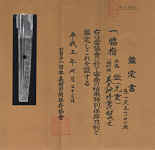|
|
O-suriage Wakizashi
|
| Blade type | Wakizashi cut down from tachi. |
| Classification | Tokubetsu Hozon-to NBTHK, 1993. Sayagaki to Osafune Motoshige by Michihiro Tanobe dated August 1993. |
| Shape (sugata) | Shinogi-zukuri, ihori-mune, chu-kissaki, tori-sori. |
| Period | Late Kamakura to early Nambokucho [1325-1350]. |
| Province | Bizen. |
| Length | 47.5cm |
| Width | 2.6cm |
| Thickness | 0.6cm at the mune machi. |
| Forging (jihada) | Mokume with o-hada of running itame, ji-nie, chikei. |
| Tempering (hamon) | Wide suguha based midare showing ear shaped elements, and some slanting patterns [saka-midare], in thick nioi with Ko-nie, ashi, saka-ashi, yo, nijuba, nie-kuzure, kinsuji, inazuma, yubashiri. |
| Point (boshi) | Hakikake, nie-kuzure, kinsuji, somewhat pointed with slight kaeri. |
| Tang | O-suriage mumei, one mekugi-ana, kiri tip, kiri yasurime. |
| Tang thickness | 0.7cm |
| Signature | Shojisha mei (owners name) inscribed; THIS IS THE FAVORITE POSSESSION OF YOSHIHISA. |
| Horimono | Futasuji-hi, with remains of bonji on nakago omote. |
Remarks:
With the emergence of the Soshu tradition in the late Kamakura
period, Japanese sword making reached its highest level of development.
Masamune, Sadamune, and their pupils brought this tradition into
prominence and it was perhaps the most dominant for its time. Motoshige
was a Bizen sword smith who came under the spell of the Soshu tradition.
He had a long and productive life making swords from late the Kamakura era
on into the Yoshino period, spanning some 50 to 60 years or more.
The earliest dated piece is from Showa 4 [1315] with the body of his work
dating from Kemmu [1334] on. There is some controversy over the length of
time he produced blades, with the idea presented that two men using the
same name could have existed. There is a great change in style over the
period where we find the best examples of his sword making, which are
numerous to say the least. Early signed pieces have been referred to as
works of the 'old Motoshige'. With the coming of Nambokucho and the
influence of the Soshu tradition, we see the 'new [and perhaps greatly
improved] Motoshige'. He seemed to have adapted well to the 'heavy duty'
style of wide body, wide yakiba swords that those turbulent years
demanded. Quite literally, he 'changed with the times'.
Throughout his life, Motoshige made blades of all types and shapes
including nagamaki. From the pure and graceful Bizen sugata with quiet and
narrow hamon, to the extended and powerful examples with vigorous yakiba
found during the Nambokucho period, Motoshige seemed to try everything at
least once. A sword made by Motoshige often combines forging techniques
found in several of the great schools working at this time. The example
presented here shows off Bizen, Bitchu, and Soshu workmanship all in one
sword. The utsuri usually found in his pure Bizen work is lacking in this
blade where Soshu style workmanship is more prominent. It is obvious these
schools were in contact with each other with many ideas exchanged and
tried. His work can strongly resemble Kagemitsu, Kanemitsu, Aoe Tsuguyoshi,
and Tsugunao, or perhaps it is the other way around.
His relationship to Sadamune as one of his "Sansaku" (The Three
Brilliant Pupils: MOTOSHIGE, NOBUKUNI, TANSU KUNIMITSU), would be
wonderful to believe, but there does not seem to be much documented
evidence to support this. Clearly at some point Motoshige became connected
with or was influenced by the Soshu tradition. He likely spent some time
studying and working with other sword smiths directly associated with the
school as well. To successfully combine these different traditions as he
did into one is proof positive of his exceptional skill.
He usually signed his blades Bishu Osafune Motoshige and often
dated them. Motoshige is among a handful of Koto smiths (Kanemoto is
another), to be given a cutting test ultimate rating of Saijo O'wazamono
during the Shinto period. This is yet another honor that points to the
quality of swords made during those remarkable times of late Kamakura and
Nambokucho. Today many of Motoshige's surviving works are rated Juyo-To or
higher.
Although greatly shortened from what was likely a full-length tachi or
O'dachi, this sword as shown fully displays all the wonderful traits found
in classic 'Soden Bizen' workmanship.
Sources: Fujishiro Koto AFU Translated by Harry Watson pp 244-45. Token
Bijutsu English Edition #1. Foldout article and oshigata.


